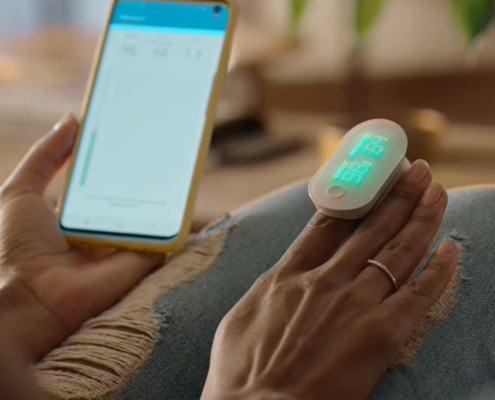Meeting regulatory requirements for the validation, approval, and use of biosensors in clinical investigations can be complex and time-consuming. Companies must navigate various regulations, standards, and guidelines issued by regulatory agencies such as the FDA and EMA.
Validation of DHTs (Digital Health Technologies) for use in Clinical Investigations
The FDA classifies biosensors as digital health technology (DHT) which is a system that uses computing platforms, connectivity, software, and/or sensors for health care and related uses1. Biosensors are most often seen as a wearable health technology/wearable sensor. One common example of wearable sensor technology is a personal fitness watch like Apple or Fitbit. But biosensor use isn’t just limited to personal fitness watches, they are also used in clinical investigations to capture data and endpoints, as well as monitor the patient’s health.
Biosensors have become increasingly integral in clinical investigations, offering precise real-time monitoring of various biological parameters. In 2019, approximately 15% of trials incorporated wearable devices, primarily to collect data as explanatory endpoints and monitor patients’ health2. Currently, the percentage of clinical investigations reporting the use of wearables biosensors as primary or secondary endpoints on clinicaltrial.com is less than 1%. Though usage is low now, it is anticipated that up to 70% of clinical investigations will incorporate wearable sensors by 20253.
Depending on the intended use of the DHT, the DHT may meet the definition of a medical device under the Federal Food, Drug, and Cosmetic Act (FD&C Act)4. If a DHT meets the definition of a medical device, developers and stakeholders must now consider and include information regarding DHTs in their regulatory submission (i.e. IND, IDE, DDT submission, MDDT submission).
There are many applications of biosensors in clinical investigations, ranging from assessing drug efficacy and safety to monitoring patient response and disease progression. When used as endpoints, they function as a powerful tool for enhancing the efficiency, accuracy, and patient-centricity of clinical investigations. Due to the flexible applications and benefits they offer, we can see why biosensors are being increasingly used in clinical investigations.
Challenges for Industry
Despite the benefits and advantages that biosensors offer, they also pose significant challenges. Some key obstacles to consider include:
Regulations to Consider
Using biosensors as clinical investigation endpoints means that you will be subject to various regulations and guidelines set forth by regulatory agencies such as the U.S. Food and Drug Administration (FDA), the European Medicines Agency (EMA), and other regulatory authorities worldwide.
Guidance Documents:
Both the FDA and the EMA issue guidance documents to provide additional clarity and interpretation of regulations pertaining to medical devices, including biosensors. These guidance documents address various aspects such as clinical trial design, data collection, performance evaluation, and regulatory submission requirements specific to biosensors used in clinical investigations. Most recently, the FDA released the guidance, “Digital Health Technologies for Remote Data Acquisition in Clinical Investigations” in December of 20235. This guidance recommends that usability evaluations should be conducted to demonstrate that the DHT can be used as intended by the trial population without errors or problems, as usability evaluations are a critical component in confirming the suitability of the DHT in the proposed clinical investigation.
The guidance, “Applying Human Factors and Usability Engineering to Medical Devices” (February 2016), discusses important considerations for Human Factors Validation testing. The principles addressed in this guidance serve as an important role in medical device development as a whole but are also helpful for designing usability evaluations for DHTs proposed for use in clinical investigations of medical products6.
Compliance with these regulations and guidelines is essential to ensure the safety, efficacy, and regulatory approval of biosensors used as clinical investigation endpoints. Regulatory requirements may vary depending on factors such as the intended use of the biosensor, the jurisdiction in which the clinical investigation is conducted, and the classification of the biosensor as a medical device. Therefore, it’s important for sponsors and investigators to stay informed about relevant regulations and seek regulatory guidance as needed throughout the clinical investigation process.
Our Solution
If you are hoping to use biosensor data as a part of your regulatory submission, the biosensors will need to be validated to show that they are accurate and reliable. Improvita provides comprehensive validation services to define the performance characteristics such as accuracy, precision, sensitivity, specificity, linearity and stability. Our team provides support through the planning execution and reporting of validation activities.
Biosensor data from clinical trials is only useful if patients adhere to their use during trials. Our Human Factors Services provide an added advantage to address patient acceptance and compliance. Improvita can conduct Human Factors and/or Usability Testing to investigate patient comfort, ease of use, and privacy concerns when designing biosensors and implementing monitoring procedures. In addition, we provide the support to validate Instructions for Use that will guide patients through the use of one or more biosensors utilized in a clinical investigation. Human Factors studies are also likely to be a necessary part of the overall product submission, so work done to improve safety and adherence during clinical trials will likely also be useful with broader HF requirements7.
Why Choose Improvita for your validation of DHTs?
Revolutionize your clinical investigations with cutting-edge biosensor validation from our expert team at Improvita, while ensuring accuracy, reliability, and compliance every step of the way. Partnering with Improvita can unlock the full potential of your biosensors and accelerate your path to regulatory approval.
To learn more about how to elevate your research and drive meaningful advancements in DHTs, contact us today to discuss your specific needs.
References:
- https://www.fda.gov/media/155022/download
- https://www.pharmavoice.com/news/2019-03-wearables/612482/
- https://www.ncbi.nlm.nih.gov/pmc/articles/PMC7600024/
- https://www.accessdata.fda.gov/scripts/cdrh/cfdocs/cfcfr/CFRSearch.cfm?fr=801.4
- https://www.fda.gov/regulatory-information/search-fda-guidance-documents/digital-health-technologies-remote-data-acquisition-clinical-investigations
- https://www.fda.gov/regulatory-information/search-fda-guidance-documents/applying-human-factors-and-usability-engineering-medical-devices
- https://www.fda.gov/regulatory-information/search-fda-guidance-documents/applying-human-factors-and-usability-engineering-medical-devices
